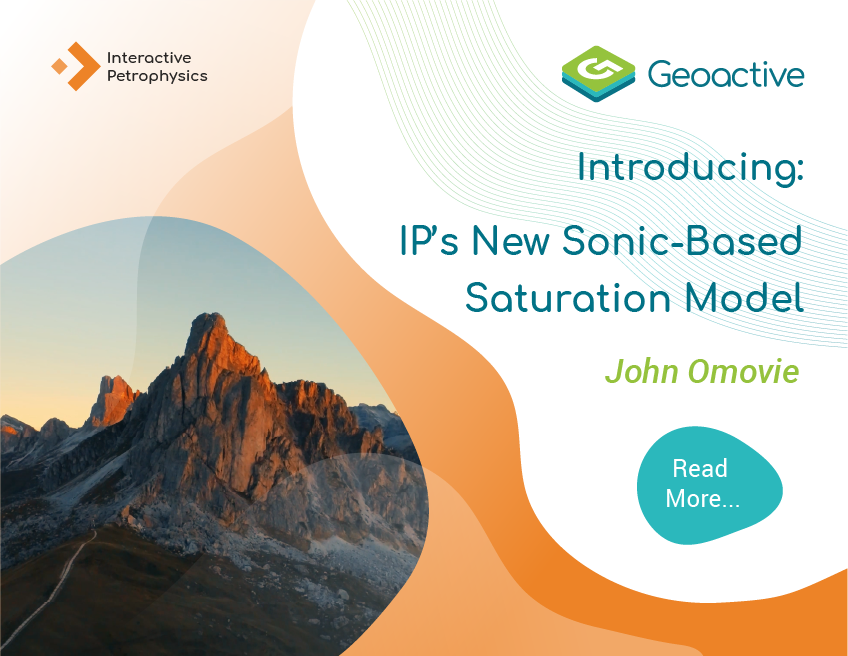The Importance of Feature Selection for Machine Learning in Petrophysics
When planning and building machine learning models, a question often asked is, “What features should I use as input to my model?”.

In the evolving landscape of reservoir evaluation, traditional resistivity-based models often fall short, especially in low-resistivity, low-contrast (LRLC) environments where fluid differentiation is subtle and complex. To address these limitations, IP has developed a new sonic-based saturation model that leverages elastic rock properties to deliver more reliable saturation estimates. By focusing on parameters like bulk modulus and density - properties less influenced by variables such as formation water salinity or clay content - this model offers a more robust and physics-driven approach to saturation analysis. Before we explore why this sonic-based method outperforms resistivity-based models in LRLC reservoirs, let’s take a closer look at the challenges it was designed to overcome.
The new sonic-based model in IP outperforms resistivity-based saturation models in low-resistivity, low-contrast (LRLC) reservoirs because it relies on elastic properties—such as bulk modulus and density - that are far less affected by formation water salinity, clay content, or conductive minerals. Resistivity-based models (like Archie’s equation), on the other hand, struggle in these environments because the contrast between hydrocarbon-bearing and water-bearing zones is often too small to reliably differentiate fluids. The sonic-based model offers a more direct connection between fluid saturation and changes in the rock frame and pore space, leading to more accurate saturation estimates where resistivity methods fall short.
Consider, for example, the impact of formation water salinity on both models. The figure below shows a crossplot of bulk modulus for various reservoir fluids versus pressure at 150°F, with fluid properties computed from Batzle and Wang (1992) and Han and Batzle (2000). At 8,000 psi reservoir pressure, the bulk modulus of brine at 100,000 ppm salinity is 3.3 GPa, compared to 2.8 GPa at 10,000 ppm - a 15% change despite an order-of-magnitude difference in salinity. Brine density varies only slightly as well, from 1.03 g/cc at 10,000 ppm to 1.1 g/cc at 100,000 ppm.
In contrast, resistivity shows a much stronger sensitivity: brine resistivity drops from 0.294 ohmm at 10,000 ppm to 0.038 ohmm at 100,000 ppm - nearly an order-of-magnitude difference. This highlights why resistivity-based models often fail to accurately estimate water saturation in low-salinity, low-contrast siliciclastic reservoirs. The sonic-based model, however, remains largely unaffected by such changes.
For a more detailed analysis of brine salinity sensitivity in a gas condensate reservoir, please see the Sensitivity to Brine Salinity section of our OTC paper (Omovie, 2025).

Bulk modulus of various reservoir fluids at 150 °F and varying reservoir pressure. Rw is brine resistivity and Cw is brine conductivity.
References:
Batzle, M., & Wang, Z., 1992, Seismic properties of pore fluids. GEOPHYSICS, 57(11), 1396-1408. https://doi.org/10.1190/1.1443207
Han, D. H.; Batzle, M. Velocity, density and modulus of hydrocarbon fluids — Empirical modeling. In SEG Technical Program Expanded Abstracts 2000, pp 1867-1870.
Omovie, S. J. "A New Method of Estimating Water Saturation Using Acoustic Logs – Applications to Oil Reservoirs." Paper presented at the Offshore Technology Conference, Houston, Texas, USA, May 2025. doi: https://doi.org/10.4043/35909-MS
In this short post we briefly explain the reason why the new sonic-based saturation model is more effective than resistivity-based saturation models in low-resistivity, low-contrast reservoirs.
The sonic model has successfully been applied to shaly sand and organic shale reservoirs.

When planning and building machine learning models, a question often asked is, “What features should I use as input to my model?”.

Geomechanics has become a cornerstone for success in subsurface activities, ranging from hydrocarbon extraction and fractured reservoirs to CO₂...

Geomechanics plays a crucial role in addressing some of the most pressing challenges faced by the oil and gas industry. Here are the key challenges...